"Working through the stacks of publications I have accumulated over the last year, the following stand out:
The Winter 2019 issue of Spike Art Magazine is dedicated to Magic! To cast their spell, the editors insist we read this issue cover to cover. From Erik Davis on magic and technology to poets CAConrad and Ariana Reines’ speculation on war as masculine menstrual envy to Suzanne Treister’s techno tarot cards or Tony Oursler’s archive of the occult, this is a gripping celebration of witchiness and art.
Theme shows are a good way of divining golden threads and making discoveries. What links Wassily Kandinsky, Arnold Schönberg, Marianne von Werefkin (new to me) and Cage? Music and Spirituality in Art, as beautifully charted in the eponymous catalogue (2017) for a show at Palazzo Magnani in Reggio Emilia.
Out of MuHKA’s (Museum of Contemporary Art Antwerp) catalogue for their 2019 retrospective of James Lee Byars (The Perfect Kiss) slips a facsimile of his 1970 lecture describing the genesis of his World Question Center, a clear precursor of Wikipedia. Byars is later televised phoning all the cleverest people in the world and asking them: "What questions are you asking yourself?"
As if braced for a more austere future, artists have been publishing slim volumes of subtle poesy. Georgie Hopton and Gary Hume’s Hurricanes Hardly Happen (2020) is a delightful juxtaposition of two artists noodling with nature. Richard Deacon’s I Wanted to Talk About the Future But I Ended Up thinking About the Past (2019) is about footprints and fossils. Each can be slipped in the pocket and carried to the park for our daily constitutional.
Into the Night: Cabarets and Clubs in Modern Art (2019): the superb book accompanying the Barbican’s recent survey of the European avant-garde’s love affair with absurdity and alcohol charts the pleasures we are missing through the lockdown.
Dan Byrne-Smith acts as our guide through the dystopias and utopias of science fiction in the latest Documents of Contemporary Art (2020). Riveting fragments by artists ranging from Laylah Ali to the Otolith Group are divided across the themes of cognitive estrangement, futures, posthumanism and ecologies. A vital tool for our post-epidemic future."





